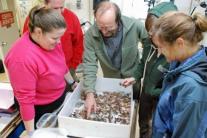Dr.
University research on deep-sea corals featured in documentary
Thu, 06/25/2015 - 2:55pmResearch related to sea corals conducted at the University of Louisiana at Lafayette is featured in a video recently released by the national Bureau of Ocean Energy Management.
The documentary, “Pathways to the Abyss,” outlines initial findings of a five-year, $9 million study of underwater canyons off the coasts of Maryland and Virginia. Scientists are researching submarine topography and marine habitats in the Baltimore and Norfolk canyons for potential offshore energy and mineral exploration.
Researchers from universities, government, and industry are mapping largely unexplored areas, documenting shipwreck locations, and studying samples of fish, coral and other organisms. The specimens were collected during expeditions in the summers of 2011, 2012, and 2013.
UL Lafayette’s Dr. Scott France, a biology professor, and Esprit Heestand Saucier, a doctoral student, participated in two of those expeditions.
The focus of their research is “how far corals and their offspring disperse,” France explains during one portion of the video.
In a recent interview, he described their studies this way: “We are working on the genetics of some of the corals to determine where might these corals be coming from? Can they travel long distances?”
Saucier, who is working on her dissertation, spent several weeks during the summers of 2012 and 2013 aboard ships in the Atlantic Ocean.
She’s studying the genetics of bamboo coral. The species is so named for its “branches,” called skeletons, which resemble stalks of bamboo. Relatively little is known about the deep-sea corals.
Saucier wants to know how far bamboo coral larvae can “travel.” In other words, can its reproductive larvae survive long enough, while being carried far distances by ocean currents, to “find” adequate habitat for attaching itself?
“We’re interested in seeing if corals that were found in certain canyons are endemic to those canyons,” she said.
France said he and Saucier found extensive beds of corals, “but there were other exciting finds as well.”
One of those discoveries was large fields of chemosynthetic mussels, or those that glean energy from hydrogen sulfide and methane that bubbles up through the ocean floor via fissures called seeps, or vents. “They are known in various places in the world, but we had no idea that there were these huge fields in these canyons,” he said.
Scientists participating in this five-year project also are analyzing information about ocean currents, temperatures, and chemistry culled from remotely operated vehicles called landers, which record data while resting on the ocean floor.
A comprehensive report from the Bureau of Ocean Energy Management, which will provide insight into geology, oceanography and ecology, is anticipated to be complete late this year or in early 2016.
Learn more about the “Pathways to the Abyss” at https://vimeo.com/128444694.
Photo:
Esprit Saucier, left, a University of Louisiana at Lafayette doctoral student, is shown with a team of scientists and researchers examining marine life during an expedition off the coasts of Maryland and Virginia. Image courtesy of the Bureau of Ocean Energy Management.

